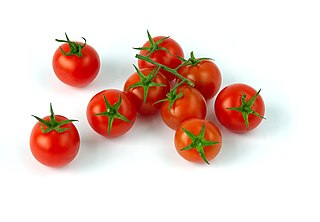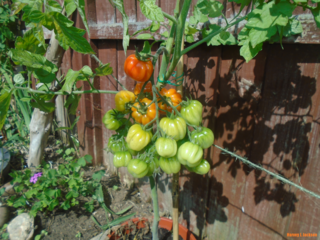Related Research Articles

The cherry tomato is a type of small round tomato believed to be an intermediate genetic admixture between wild currant-type tomatoes and domesticated garden tomatoes. Cherry tomatoes range in size from a thumbtip up to the size of a golf ball, and can range from spherical to slightly oblong in shape. Although usually red, other colours such as orange, yellow, green, purple, and black also exist. Those shaped like an oblong share characteristics with plum tomatoes and are known as grape tomatoes. The cherry tomato is regarded as a botanical variety of the cultivated berry, Solanum lycopersicum var. cerasiforme.

A beef tomato or beefsteak tomato is a large tomato. Grown on the plant Solanum lycopersicum, it is one of the largest varieties of cultivated tomatoes, regularly at 20 cm (6 in) in diameter with some weighing 450 g (1 lb) or more. Most are pink or red with numerous small seed compartments (locules) distributed throughout the fruit, sometimes displaying pronounced ribbing similar to ancient pre-Columbian tomato cultivars. While popular among home growers for beef sandwich toppings and other applications requiring a large tomato such as toppings on large steaks, beefsteaks are not grown commercially as often as other types, since they are not considered as suitable for mechanization as smaller slicing tomatoes. Non-commercially, however, they are the most popularly grown tomato in North America.

Solanum pimpinellifolium, commonly known as the currant tomato or pimp, is a wild species of tomato native to Ecuador and Peru but naturalized elsewhere, such as the Galápagos Islands. Its small fruits are edible, and it is commonly grown in gardens as an heirloom tomato, although it is considered to be wild rather than domesticated as is the commonly cultivated tomato species Solanum lycopersicum. Its genome was sequenced in 2012.

The tomato is the edible berry of the plant Solanum lycopersicum, commonly known as the tomato plant. The species originated in western South America, Mexico, and Central America. The Nahuatl word tomatl gave rise to the Spanish word tomate, from which the English word tomato derives. Its domestication and use as a cultivated food may have originated with the indigenous peoples of Mexico. The Aztecs used tomatoes in their cooking at the time of the Spanish conquest of the Aztec Empire, and after the Spanish encountered the tomato for the first time after their contact with the Aztecs, they brought the plant to Europe, in a widespread transfer of plants known as the Columbian exchange. From there, the tomato was introduced to other parts of the European-colonized world during the 16th century.

Alternaria solani is a fungal pathogen that produces a disease in tomato and potato plants called early blight. The pathogen produces distinctive "bullseye" patterned leaf spots and can also cause stem lesions and fruit rot on tomato and tuber blight on potato. Despite the name "early," foliar symptoms usually occur on older leaves. If uncontrolled, early blight can cause significant yield reductions. Primary methods of controlling this disease include preventing long periods of wetness on leaf surfaces and applying fungicides. Early blight can also be caused by Alternaria tomatophila, which is more virulent on stems and leaves of tomato plants than Alternaria solani.

Phoma destructiva is a fungal plant pathogen infecting tomatoes and potatoes.
Tomato black ring virus (TBRV) is a plant pathogenic virus of the family Secoviridae, that was first discovered in 1946.

Manduca blackburni, the Hawaiian tomato hornworm, Hawaiian tobacco hornworm or Blackburn's sphinx moth, is a moth in the family Sphingidae.

Solanoideae is a subfamily of the flowering plant family Solanaceae, and is sister to the subfamily Nicotianoideae. Within Solanaceae, Solanoideae contains some of the most economically important genera and species, such as the tomato, potato, eggplant or aubergine, chili and bell peppers, mandrakes, and jimson weed.
The Hillbilly Tomato, scientific name Solanum lycopersicum, is an heirloom cultivar originating from West Virginia in the 1800s. There is also a potato-leaf variant named Hillbilly Potato Leaf. The fruit is considered a beefsteak tomato weighing 1-2 pounds. It is round, heavily ribbed and its skin and flesh is orange-yellow with red streaks. The flavor is described "sweet and fruity" and is low in acid.

The Celebrity tomato cultivar is a hybrid (biology) that produces long fruit-bearing stems holding 20 or more very plump, robust tomatoes. Fruits weigh approximately 8 oz., and are 4 inches across. Plants need caging or staking, and produce fruit throughout the growing season. The celebrity tomato is a cultivar of the species Solanum lycopersicum. It is a crossbreed of the common tomato that is widely used for various culinary purposes. This tomato is of great size and is known to be resistant to most tomato diseases such as Fusarium wilt, Verticillium wilt, Tobacco mosaic virus and Root-knot nematode due to its hybrid nature. Celebrity tomatoes are highly adaptive to harsh environments and can grow in a wide range of places including dry, humid and wet regions. They are resistant to cracking and splitting which usually occurs when there is an excess of water and sugar movement in the fruits. Therefore, causing the tomato skin to grow at a slower rate compared to the expansion of the fruit. They can survive in harsh uneven rainfall. However, they are highly susceptible to colder environments and are at a higher risk of dying in regions with short growing seasons. The plants can grow up to 5 feet in height with bright red medium-sized fruits. The plants are generally very thick and grow in clusters. The tomato fruits are mostly used in the making of various salsas, salads, juices and canned food.

The Raf tomato is a tomato obtained from artificial selection practiced on traditional tomatoes are planted outdoors since 1961. It is originally from Spain. The Raf tomato Marmande is a variety which stands out for its flavor and texture, as well as its resistance to water with high salt content.

The Solanaceae, or the nightshades, are a family of flowering plants that ranges from annual and perennial herbs to vines, lianas, epiphytes, shrubs, and trees, and includes a number of agricultural crops, medicinal plants, spices, weeds, and ornamentals. Many members of the family contain potent alkaloids, and some are highly toxic, but many—including tomatoes, potatoes, eggplant, bell and chili peppers—are used as food. The family belongs to the order Solanales, in the asterid group and class Magnoliopsida (dicotyledons). The Solanaceae consists of about 98 genera and some 2,700 species, with a great diversity of habitats, morphology and ecology.
Siberian tomato is a type of the common tomato plant. It is referred to as "Siberian" because it can set fruit at 38 °F (3 °C), although it is not particularly frost hardy, despite its name.
Dactylosporangium solaniradicis is a bacterium from the genus Dactylosporangium which has been isolated from roots of the tomato plant Solanum lycopersicum from a farm in Xiangfang, China.
The Jersey Boy tomato is a type of beefsteak tomato in the family Solanaceae, a hybrid cultivar of the Rutgers and the Brandywine tomatoes by Burpee Seeds. It made its first appearance as commercial seed registered 2014 and released circa 2015.
Phytophthora hydropathica is an oomycete plant pathogen that is found in aquatic environments such as irrigation and river water. The pathogen was previously classified as P. drechsleri Dre II before being categorized as its own distinct species. P. hydropathica has been primarily found in association with ornamental plant nurseries. The pathogen has been isolated throughout the Southern United States, as well as internationally in Mexico, Italy, and Spain.

The Tomkin tomato is a small, pumpkin shaped variety of tomato first grown in the United Kingdom by a British farmer in Lancaster. The Tomkin tomato is sold exclusively in a supermarket called ASDA.
Tomato mottle mosaic virus is a Tobamovirus which infects Solanum lycopersicum. First detected in Mexico in 2013 from S. lycopersicum samples taken in 2009, ToMMV has since been found throughout the world. In 2014 some S. lycopersicum samples from Florida in 2010 and 2012 and a Nicotiana tabacum 'Xanthi nc' sample were retested using an assay that distinguishes ToMMV from other Tobamoviruses, especially the closely related Tomato mosaic virus and Tobacco mosaic virus. These samples tested positive for ToMMV, showing that ToMMV was widespread and had been for several years earlier than previously known.
References
- ↑ "Plant database entry for Tomato (Solanum lycopersicum 'Three Sisters') with 35 data details". National Gardening Association Plants Database. Retrieved 2022-04-12.
- ↑ "Tomato 'Three Sisters' Lycopersicon lycopersicum". Dave's Garden . 2008-07-20. Retrieved 2022-04-12.